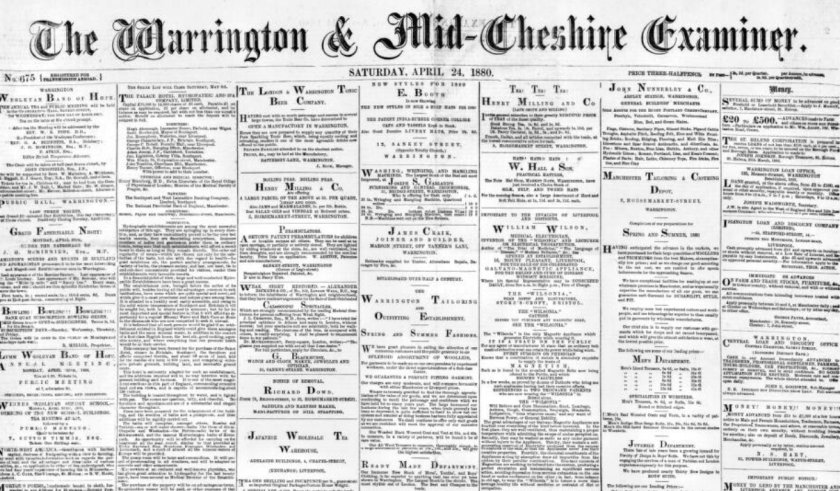Letters to the Editor…
Warrington Examiner – Saturday 24 April 1880
Sir, As “the mild season, that time when rain from above falling makes all things green, and springing flowers awake from sleep and hail the wished-for day,” invited to take a walk, and the time being convenient, I strolled into Burtonwood, or, as perhaps it ought to be called, Bowyer-town-wood, passing the ruins of the mill erected by T.P.L., 1793, and under the viaduct, a picturesque object, as seen from Newton Common, and on to Bradley Hall (similar in name and fame to that at Grappenhall) and once the moat-house of the ancestors of the Legh’s, of Lyme, pausing to admire the springing flowers with as much zest as our Norse forefathers, and after viewing the ivy-grown ruins of the gateway, I turned my steps down the valley of the Sankey, a good bow shot to the ancient home of the Atherton’s, the ancient landlords of Newton, and known as “Old Hey,” a manor house of 200 years ago, with its massive brick walls in excellent preservation, with nine windows in front, built on a vantage ground above the valley, and calculated to withstand wind and weather for as much longer. The kitchen is unusually capacious, and the staircases are wide and curious. In the barn is the date 1730, on a tie beam. Within similar distance is New Hey; and following the main stream would bring us to Winwick, which stands clear from its bower of trees. But turning to the east we pass Wargrave—a place of some antiquity, if names go for ought—and the Mains or Demesnes, of the ancient home of the Blackburne’s, known as Newton Hall, built in 1605, the year of Gunpowder Plot. It has the armorial bearings of the Blackburne’s, but not the grotesque wooden heads of the Old Hey Farm, although it is much older.
Passing under Newton Bridge, and by the mill, we look over the bridge on the high street to where the ancient bridge and smithy stood, halfway between it and the dam which confines the waters of the Mere. At the angle of the lake is “Castle Hill,” a full description of which will be found in the Manchester Philosophical Society’s Transactions for 1846, when the barrow was opened in the presence of local antiquaries; and when a footpath led across to Golborne Park another residence of the Legh’s, and there were remains of cottages thereabouts. A few hundred paces further up is the Dean Moor School, of date 1677. Pursuing our course up the high street from the bridge we pass the site of another school. Opposite to the entrance of the “Cockpit” School stood another still more ancient school, mentioned by Defoe in his “Itinerary of Great Britain” and the “Blue Crows” of the District; but root and branch are gone, for both schools have disappeared in the lapse of time, and the very ground the first stood upon has been hewn away to make room for a carriage drive. Adjoining is the Church of St. Peter’s, founded in 1685 and rebuilt in 1834, when the district was provided with churches in order to counteract the influences of dissent, and notably that of Crow-lane Chapel. The old coaching-house, and the older part of the town itself, are all cleared away, the one to find room for an addition to the church burial ground and the other to make way for Park-road.
Passing up the high street and then by Rob lane we reach the Dean School, and pause to think why it was ever called the Dean School, for there never was a deanery anywhere near to it. At last it dawns on our intelligence that it is simply the school in the valley—from the Anglo-Saxon word Denu, a valley. Yes; there it stands to remind us that it still supplies part of the means for those “exhibitions” or scholarships about to be thrown open to deserving boys in our public schools in Newton and Earlestown, but again, and to-day, for unknown reasons, “postponed,” and which postponement will be very mortifying to the boys, and to the parents of those boys, who are ready and willing to stand the test of examinations for these scholarships and who most likely will have to go to work and let others carry off the prizes. We merely note this fact in a timid kind of way, and by way of protest in passing, and continue our walk to the Dean Dam, a sylvan resort of the better sort, inferior only to the Lady Hill Dam, where surely none but fairies dwell, a veritable fairy dell, where “Bottom” might easily have been made in to an ass.
Yours truly,
RUSTICUS, Newton-le-Willows, April 20, 1880.



